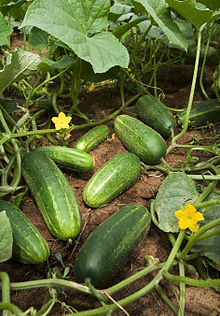**Botanical Characteristics and Cultivation**:
– Cucumber is a creeping vine that grows up trellises or supporting frames.
– Cucumber fruits are cylindrical, elongated, and contain 95% water.
– Most cucumber cultivars require pollination by bees.
– Some self-compatible cultivars and parthenocarpic cultivars exist.
– Cucumbers produce cucurbitacin C for herbivore defense.
– Cucumber is classified as a pepo, a type of botanical berry.
**Nutritional Value and Varieties**:
– Raw cucumber is 95% water, 4% carbohydrates, and 1% protein.
– Cucumbers are low in micronutrients but rich in vitamin K.
– Different varieties of cucumbers include slicing, pickling, and seedless/burpless types.
– Slicing cucumbers are for fresh consumption, while pickling cucumbers are used for various flavored products.
– Burpless cucumbers are sweeter, nearly seedless, and have delicate skin.
**Global Production and Historical Significance**:
– China led in cucumber and gherkin production in 2020, accounting for 80% of the total.
– Other top cucumber producers include Turkey, Russia, Iran, and Mexico.
– World production of cucumbers and gherkins in 2020 was 91 million tonnes.
– Cucumbers have a rich historical significance, with mentions in Roman Empire, Middle Ages, and early-modern age.
– Evolution of perceptions towards cucumbers over time is documented.
**Scientific Research and Genetic Studies**:
– In 2009, the cucumber genome was sequenced.
– Research on cucumber genetics, diversity, breeding, and domestication is ongoing.
– Studies have been conducted on terpene synthases in cucumbers.
– FDA guidelines on cucumber nutrition labeling are available.
– Insights from phylogenies, genomics, and archaeology shed light on cucumber origin and domestication.
**Culinary Uses, Nutrition, and Health Benefits**:
– Cucumbers are low in calories, high in hydration, and rich in vitamins, minerals, and antioxidants.
– They have digestive benefits and cooling properties.
– Cucumbers are commonly used in salads, pickling, and various culinary dishes.
– They play a significant role in traditional plant foods of various cultures.
– Cucumber’s unique uses in beverages, skincare, and home remedies are noted.
The cucumber (Cucumis sativus) is a widely-cultivated creeping vine plant in the family Cucurbitaceae that bears cylindrical to spherical fruits, which are used as culinary vegetables. Considered an annual plant, there are three main types of cucumber—slicing, pickling, and seedless—within which several cultivars have been created. The cucumber originates in Asia extending from India, Nepal, Bangladesh, China (Yunnan, Guizhou, Guangxi), and Northern Thailand, but now grows on most continents, and many different types of cucumber are grown commercially and traded on the global market. In North America, the term wild cucumber refers to plants in the genera Echinocystis and Marah, though the two are not closely related.
| Cucumber | |
|---|---|

| |
| Cucumbers growing on vines | |

| |
| A single cucumber fruit | |
| Scientific classification | |
| Kingdom: | Plantae |
| Clade: | Tracheophytes |
| Clade: | Angiosperms |
| Clade: | Eudicots |
| Clade: | Rosids |
| Order: | Cucurbitales |
| Family: | Cucurbitaceae |
| Genus: | Cucumis |
| Species: | C. sativus
|
| Binomial name | |
| Cucumis sativus | |
